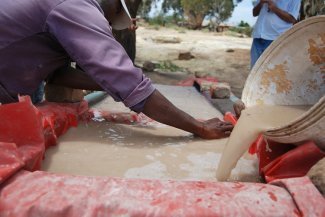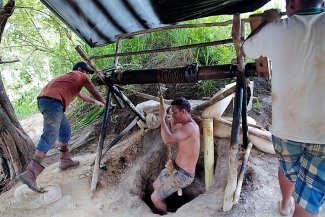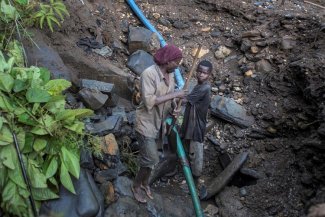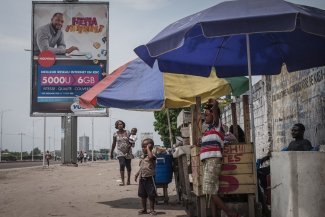
The mining pit in Kambelé that claimed the life of 16-year-old child miner Jean Daniel Zamboure on Monday 13 June 2022 has been sealed off by the prefecture of the Kadey department.
The village of Bakombo is located in the district of Batouri in the heart of the equatorial rainforest of eastern Cameroon, 400 kilometres from the capital of Yaoundé. On this sunny morning, the sound of birds singing mingles with the deafening roar of the vehicles that constantly pass. Today, this village of 1,000 inhabitants is mourning the disappearance a few days earlier of one of its sons: 16-year-old Jean Daniel Zamboure. The young man lost his life on Monday 13 June 2022 when a mining pit at the Kambelé III mining site, located 20 kilometres from the village, collapsed.
In front of his family’s hut, relics from the funeral ceremony which took place the following Saturday are still on display in a small tent covered in palm leaves, located close to the pile of earth that marks his grave site. Inconsolable, his mother Angeline Ndedesi stands at the gravesite with her boyfriend Jérémie Nouma mourning the death of her son who died under disturbing circumstances.
Jérémie, 18, could have lost his life that day too, but miraculously escaped. “There were a lot of us in the pit when it caved in. The earth covered several diggers. I managed to escape. At that moment, I didn’t realise that Jean Daniel was still buried. After a little while I didn’t see him among the survivors and I began to worry. We started looking for bodies,” the teenager tells Equal Times, his voice trembling, the trauma etched onto his face. Jérémie has not returned to the site since that day.
Though enrolled at the local public school, Jean Daniel had little love of scholastics and made only occasional appearances there as he engaged in child labour in the gold mines. He travelled to Kambelé III between three and four times a week. The money he occasionally earned there – up to 35,000 CFA francs (US$54) a week – helped support his family who live under modest circumstances, subsisting off of farming and small trade.
Gold for gain, agriculture for subsistence
The East Region is the largest of Cameroon’s 10 administrative districts. In addition to artisanal gold mining, its economy consists of traditional agriculture, livestock farming and illegal logging. Gold mining has gradually overtaken other parts of the local economy, agriculture in particular, due to the proliferation of gold mining sites in the region.
There are six in the Batouri district, including Kambelé III, where miners and their families live in haphazardly built makeshift camps that stretch on as far as the eye can see. For many, proximity to this ‘treasure’ guarantees them a regular income, far from the fields where production cycles are long and earnings seasonal.
According to a study published in 2016 by the Centre d’Excellence Pour la Gouvernance des Industries Extractives en Afrique Francophone (CEGIEAF), 66 per cent of Kambelé’s population lives from artisanal gold mining.
“Our organisation gives priority to agriculture, but given that gold mining activities have increased in our region, our members alternate between the two. We can’t stop extracting gold because we have the sites here, and we can’t stop farming because it provides us with food,” says Joseph Kendja Kombo, promoter of the joint initiative group (GIC) Producteurs Agricoles de Batouri (PRABA).
At Kamebelé III, more than 1,000 m² around the pit where Jean Daniel and another gold digger – originally from the Central African Republic – died has been sealed off by the prefect and forbidden to gold diggers. Yet the very next day, gold diggers trampled over the barrier and continue to trespass into the mine, undeterred by the tragedy that took place. These miners include natives of the East region as well as nomadic workers from the Far North region, the poorest in the country, where 74 per cent of the population lived below the poverty line even before incursions by the jihadist organisation Boko Haram began in 2011.
There are also foreigners here, who come from as far as Burkina Faso, the Central African Republic and Chad. The vast majority are clandestine artisanal miners who make do with the gold residue buried in mining pits that have been abandoned by companies that use excavators to practice semi-mechanised artisanal mining. These miners work under dangerous and unhealthy conditions.
Between 2014 and May 2022, the NGO Forêts et Développement Rural (FODER), which focuses on environmental and human rights violations at mining sites, recorded 185 deaths in the mines of the East and Adamawa regions. This trend shows no sign of letting up, with the number of deaths reaching 200 by the end of June. Many of those recent deaths resulted from the disaster which took place on 9 June at Bélita II, another gold mining site in the region.
Most blame the mining companies for the accidents. Originating from Cameroon, China, India and Greece and operating with the authorisation of the Ministry of Mines, Industry and Technological Development, these companies leave behind gaping holes on the sites they abandon, giving free rein to the artisanal miners to rush in at the risk of their lives.
According to Placide Damzon Mbelé, a member of the environment and land-use planning commission within the regional council of the East Region: “When the companies finish mining the pits they dig, they don’t close them up again. Most of the time, these pits turn into artificial lakes that workers drown in.”
“Companies also use their machinery to make mounds of earth and miners seek out these high risk areas to drill holes that cause the pits to collapse,” he says.
In September 2021, FODER conducted a non-exhaustive survey of pits abandoned as a result of this activity. They counted 703, including 139 artificial lakes on an area of 93.66 hectares. Article 136 of the new Cameroon Mining Code, adopted in 2016, specifies that the “restoration, rehabilitation and closure of mining sites and quarries are the responsibility of each operator”. However, this law has yet to enter into force. Six years later, it still awaits an implementation decree that requires only the signature of President of the Republic Paul Biya, in power since 1983. Semi-mechanised mining in Cameroon is still governed by the Mining Code of 2001 and a series of decrees, the last of which was signed on 4 July 2014, two years before the new text was adopted.
This confusion in the legal framework only serves to exacerbate the already contentious relations between mine owners and workers, which often escalate. Lawsuits are regularly filed against these companies in an attempt to get justice for the victims, but are often dismissed.
According to Rodrigue Nodem Fomene, assistant to the Mining, Environment, Health & Society Project, Phase II (ProMESS 2) within FODER, “there were accidents at the Batouri mining sites caused by the company Metallicon S.A. [in 2017]. As civil society, we provided the families with legal support.” The trial was a success and the company was found guilty and fined 2.1 million CFA francs (US$3,284). But then the company went missing and couldn’t be found anywhere. As Fomene explains, these companies often hide behind shell companies identified in the field that do not legally exist. When contacted by telephone and asked about the existence of these front companies, Yvonne Zong Abade, representative of the Ministry of Mines in the Kadey department, did not wish to respond.
Suspended mining activities and unenforced administrative measures
Yakouba Djadaï, the Prefect of Kadey, has already assessed the danger that these mining companies pose to gold workers. He signed a decree on 27 July 2022 suspending all companies operating at Kambelé III, due to the recurrence of deaths recorded at the mine site, as well as the devastating effects of their actions on the environment. The decision targeted nine companies, six of which are owned by Chinese nationals. Djadaï is now considering reforesting the site after closing the pits and then reorienting the gold miners towards the practice of agriculture. This is one of several actions that Cameroonian authorities are taking in order to mitigate some of the damage that has been done.
Every year, la Société Nationale des Mines Camerounaise (SONAMINES), created by the State in 2020 to oversee the mining sector, conducts the “zero children in the mines” operation at various mining sites in the East Region. According to Alvine Dogoua, Head of Communication for SONAMINES, the aim of this operation is to “contribute to the reintegration of children into the education system, through a set of measures to support schooling and literacy.”
According to International Labour Organization (ILO) statistics, approximately one million children aged 5 to 17 work in gold mines worldwide.
SONAMINES estimates the number of children working in the mines in the East Region at 800 in 2021. As a result, the number of school drop-outs has increased in recent years.
According to the results of a recent study conducted by the Centre Pour l’Environnement et le Développment (CED), the school drop-out rate in the locality of Betaré-Oya, one of the region’s main gold mining sites, was 91 per cent in the 2020-2021 school year. While the government banned child miners from mining sites in August 2021, local authorities do not act to ensure the strict application of the measure. In the meantime, children continue to pour into the mines.
The same is true for the use of mercury and cyanide, substances banned for mining practices by the Cameroonian Ministry of Mines since August 2019, but which gold miners continue to use to separate gold nuggets from particles. Aliou Baba, a gold digger in Kambelé III, handles this reagent on a daily basis and cares little about the effects it might have on his health. “We’ve been using it [mercury] for years and we’ve never had a problem. Around here everyone uses it,” he tells Equal Times.
Between 28 May and 5 June 2022, FODER collected hair samples from 66 gold miners in the East Region mining sites of Batouri, Ketté, Ngoura and Betaré-Oya. The samples were sent to the University of Michigan Biological Station in the United States for analysis to assess the health risk associated with the regular use of mercury by artisanal miners. As Rodrigue Nodem Fomene explains: “The results of the analyses will be compared with the World Health Organization (WHO) standard to find out if the concentration of mercury in the bodies of these gold miners is higher than the recommended threshold. We will report cases of proven infection to the miners and work with them as well as the public authorities and health centres that have already been identified to manage these cases.”
Faced with an artisanal gold mining rush, the Cameroonian government is struggling to structure and regulate the largely lawless sector, which, due to its unruly development, contributes very little to the country’s economic growth. Production is very marginal and decreased significantly from 801 to 317 kilograms per year between 2015 and 2019, a decline of 39 per cent in relative terms, according to official figures contained in the Cameroonian Ministry of Mines’ 2020 statistical yearbook. The contribution of the extractive sector to nominal GDP is estimated at only 3.15 per cent, according to the 2019 Extractive Industries Transparency Initiative (EITI) report on Cameroon.












